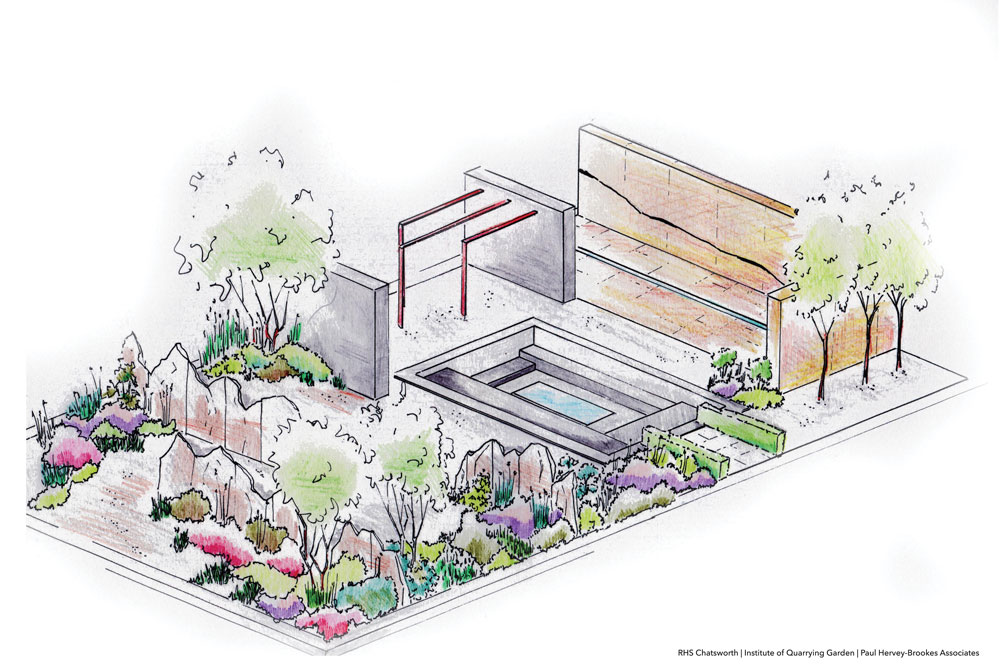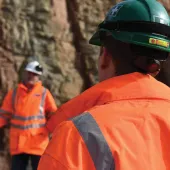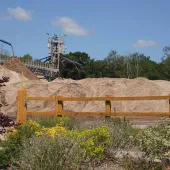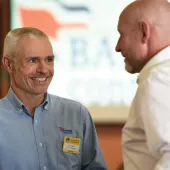Quarry Garden takes centre stage at RHS Chatsworth

First published in the May 2017 issue of Quarry Management
Institute of Quarrying to celebrate centenary year with largest show garden at first ever Chatsworth Flower Show
The Institute of Quarrying (IQ) has long provided membership and professional development services to individuals and organizations operating in the minerals and extractives industries. Now in its centenary year, IQ is celebrating by showcasing the hidden role that the sector fulfils in everyday life with its Quarry Garden at the Royal Horticultural Society’s first ever Chatsworth Flower Show, in June 2017.
It is a very long way from the earliest days of IQ, which was the brainchild of four quarry workers from Wales. One hundred years on, IQ is now a global network with more than 5,000 members, including 13 UK branches and international offices in Australia, Malaysia, New Zealand, Hong Kong and South Africa.
The Quarry Garden is the largest show garden at RHS Chatsworth. It is part of an ongoing communications strategy to open the eyes of the general public to the essential role played by the quarrying and extractives industries in today’s modern society. The original idea for the garden came from Glyn Barnes FIQ, who works for BAM Ritchies: ‘My wife and I really enjoy spending time in our garden. We’ve been to RHS Chelsea and it occurred to me that a show garden and the publicity that it receives could be a great way to raise the profile of IQ and our sector as whole.’
James Thorne, the IQ’s new chief executive, said: ‘I’ve joined IQ at a really exciting time in its 100-year history. Events such as RHS Chatsworth present us with a great opportunity to engage directly with the public. It’s all about sharing positive messages focusing on the really great things that we do as a sector.
‘Quarrying is a big part of the local economy in Derbyshire. Many of the visitors at Chatsworth will probably be blissfully unaware of the level of extraction in their local communities. That’s partially because, as an industry, we’ve become very good at staying below the radar in the communities in which we operate. That can be a good thing, but it can also lead to misinformation. We need to get better at showcasing the good things we do.
‘Many quarries actually introduce greater biodiversity during and after extraction. Take a look at the National Stone Centre, near Wirksworth. It’s the site of a former quarry yet is now a popular visitor centre. The six former limestone quarries that make up the National Stone Centre nowadays carry an interesting variety of wild plants and flowers, attracting an abundance of insects, such as bees and butterflies. Over 24 species of the 30 butterflies regularly recorded in the UK were found on this old quarry site.’
RHS Chatsworth is spread over a 28-acre site and is expected to attract more than 100,000 paying visitors. The Quarry Garden has already secured TV, radio, online and published media coverage.
Member benefits
Investing in a show garden at RHS Chatsworth will raise IQ’s profile with the general public and build stronger relationships with major industry stakeholders. The Quarry Garden project is being supported by a number of operators, which has helped to reinforce the value of IQ’s membership services and the support provided for individual professional development.
IQ is working with RHS award-winning garden designer Paul Hervey-Brookes, whose past successes include Best in Show at RHS Tatton Park and Gold medals at RHS Hampton Court and RHS Tatton Park, as well as Best in Show, Best Planting and Gold at the Gardening World Cup in Japan in 2014.
His planting scheme for the Quarry Garden is a mixture of UK native plants, naturalized plants and simple garden plants to create a beautiful ‘gardened’ space, whilst actively increasing biodiversity and habitat potential. This fits well with the concept of nature after extraction ceases and how it reclaims these spaces, often creating greater biodiversity than existed prior to extraction.
A big part of Mr Hervey-Brookes’ brief was to make the garden design an inclusive process. As an organization responsible for developing people’s skills, IQ wanted the project to inspire future generations, and that started with the design. IQ approached Nottingham Trent University’s School of Animal, Rural and Environmental Science, based at the Brackenhurst campus, near Southwell, Nottinghamshire.
Leonie Brown, course leader at Nottingham Trent University, said: ‘The Quarry Garden is an amazing opportunity for our students to get hands on with a real project. Four students took up the challenge. They were given a brief for the project and created mood boards, drawings and 3D plans of their ideas. These were then presented to a panel, including Paul Hervey-Brookes. Each student created their own interpretation of the design brief, which Paul subsequently developed into the final ‘Quarry Garden’ concept, drawing on inspiration from each student’s garden design.’
The standout feature of the Quarry Garden design is an imposing 15m wide x 3m high sculpted stone wall boundary called ‘Passing Light’. This features a series of horizontal fissures allowing visitors to view the garden through the wall. Part of Mr Hervey-Brookes’ original design concept, somewhere along the way it was lauded that ‘wouldn’t it be great if we could embed the garden in the local landscape and source the stone for the wall from a Chatsworth quarry?’
Sean Doxey, head of special operations at Chatsworth, is the man responsible for organizing the new stone being used in Phase 4 of the Chatsworth Masterplan restoration project. He said: ‘The stone is quarried from the Chatsworth estate’s Burntwood Quarry, near Beeley, using traditional quarrying techniques. This will provide 29,160 tonnes of gritstone for heritage repairs on the Grade 1 listed Chatsworth House, park and gardens, and elsewhere on the estate, including historic structures such as Flora’s Temple.
‘As part of the restoration project, a world-leading geologist provided us with advice on the gritstone and a team of expert stonemasons examined each quarried block for quality. The stone rejected by the masons cannot be sold and is recycled for use on estate roads.’
So, what does this have to do with the Quarry Garden? Well, much to IQ’s delight, Chatsworth has donated a rather large supply of rejected gritstone that cannot be used for the house restoration for use in Mr Hervey-Brookes’ wall sculpture. It is the same stone from which Chatsworth House is constructed.
The garden is made up of three main sections:
Stone wall – Passing Light sculpture
The wall at the far end of the garden is 3m high and will have a fissure sculpted along its total width to cast interesting shadows as the natural light passes behind the wall. The purpose of the gap is to encourage everyone to look at natural resources differently, to understand that they are a necessary part of everyone’s lives and that in managing them carefully, sustainable environments can be created.
Working site
The concrete pit demonstrates that through mineral extraction, the environment is being carefully managed even whilst being actively worked. The freestanding concrete walls and metal struts will make the connection between the natural environment and the built environment, to explain the use of minerals in everyday life.
Habitat creation
The naturalistic planting will be reflective of the sorts of plants that would be found in both active and former quarry sites. The message here is about the value that quarrying adds to the landscape in terms of increased biodiversity amongst plants and wildlife.
Now all Mr Hervey-Brookes and his team have to do is get several tonnes of rock off site and over to sculptor Ann-Margreth Bohl, whose job it is to carve a series of fissures into the 40cm deep wall.
The sculpture will stand the test of time, as IQ plans to repurpose the garden and the sculpture at the National Memorial Arboretum, once the dust has settled from the RHS show. It will be a fitting and lasting tribute to the important role that quarrying plays in the UK and global economy.
RHS Chatsworth runs from 7–11 June 2017 at Chatsworth, in Derbyshire. For more information visit: www.quarrygarden.org and www.rhs.org.uk
- Subscribe to Quarry Management, the monthly journal for the mineral products industry, to read articles before they appear on Agg-Net.com






